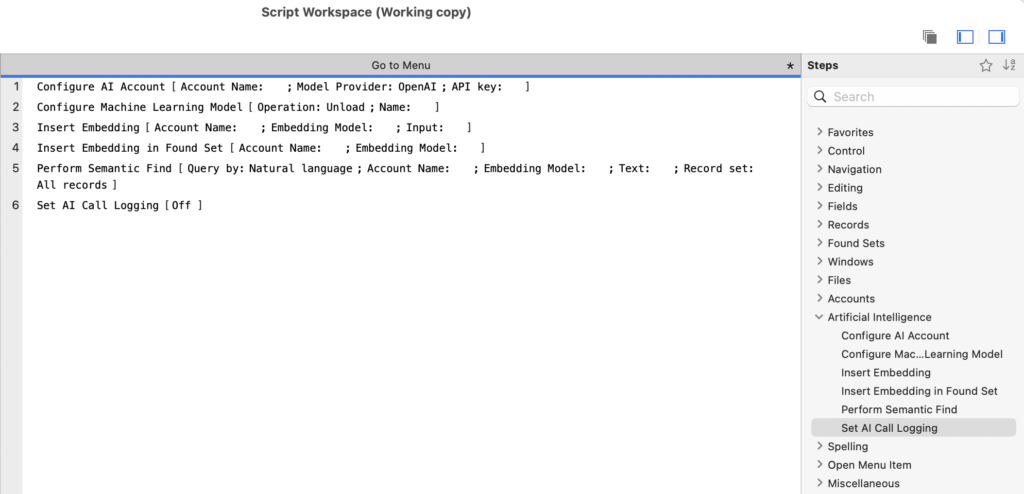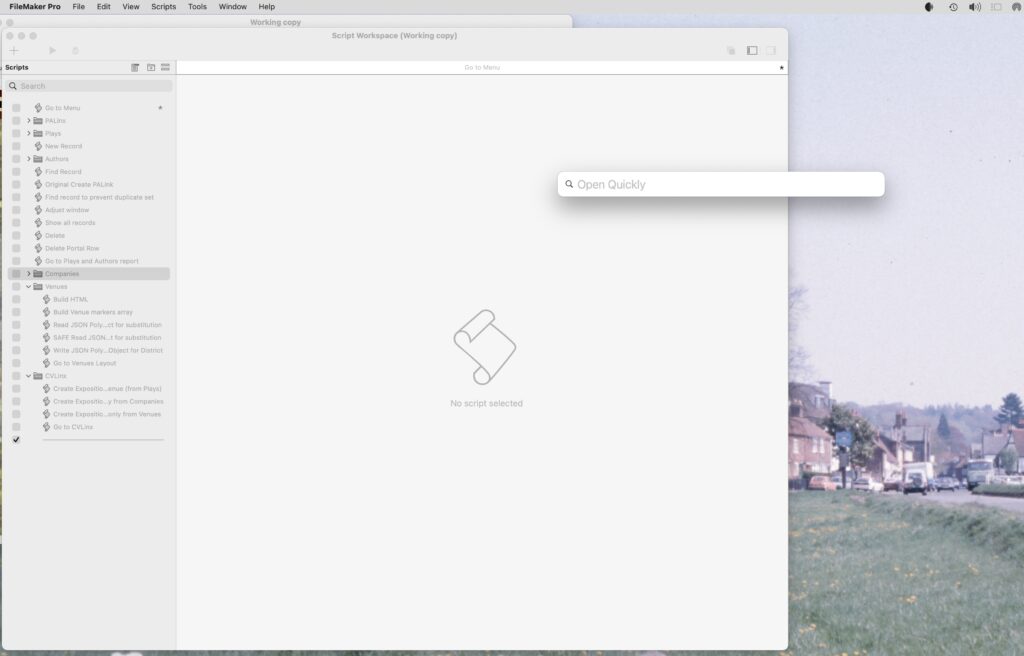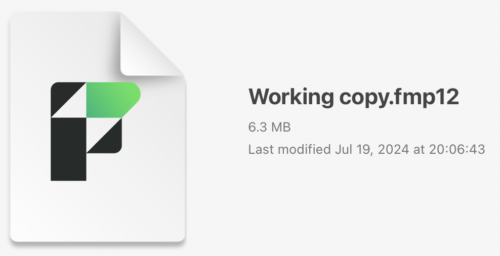FileMaker Pro 2024 has new features and enhancements as well as many fixes. Existing users will want to upgrade without hesitation!
By Mark Sealey – August 2, 2024
Claris, the wholly-owned Apple subsidiary, has released FileMaker Pro 2024, staying with its summer release schedule. This evaluative review follows all others in recent years by finding much of positive in this venerable, multi-purpose app.
As was explained in MyMac’s review this time last year, FileMaker Inc. is now Claris – the name by which the company which brought us ClarisWorks and eM@iler (on which the Apple Mail application was based) was first known.
Given FileMaker’s origins as database software, it should be noted once more that FileMaker is a fully-fledged development platform with a sophisticated and a very powerful RDBMS at its heart. Again, see previous reviews on MyMac.
Version 21.0.1 was evaluated for this review, on macOS 13.6.7. (That numeric version for FileMaker Pro 2024 is being kept in certain circumstances… for instance the “About” box, for developer functions and precision when dealing with Claris’s technical support operation.)
FileMaker Pro 2024 has new features and enhancements as well as many fixes. Existing users will want to upgrade without hesitation; see Pricing and Subscriptions, below.
Artificial Intelligence
Unsurprisingly, AI (Artificial Intelligence) tops the list of the product range’s new features.
New script steps and functions have been integrated seamlessly into FileMaker Pro 2024. Now you can both use data from a FileMaker Pro app with LLMs (Large Language Models), and “Perform Semantic Find” to return results more accurately/intelligently and more quickly than searching by/for keyword(s).
FileMaker Pro 2024 introduces these five new script steps to take advantage of fast-growing AI environments:
- use Configure AI Account to set up an AI account – given a name, model provider and (the right) API key
- Insert Embedding assigns the vector representation of the specified input text to a field or a variable
- Insert Embedding in Found Set is the vector representation of the contents of a specified field; it is inserted either into a field for all records in a found set or to a specified variable
- optionally use Set AI Call Logging to log all AI script steps and function calls to a specified file – either new or by adding to an existing file, depending on the corresponding “Filename” parameter
- the “Perform Semantic Find” script step works “internally” on your data. It searches for records where the content of the field in question matches the query semantically. The parameters for the “Query by” option either employ Natural Language, where the query text is sent to the specified model for conversion to embedding vectors; or by employing vector data – where you provide the embedding vectors as container data for your query. This is likely to be more efficient in the case of queries which are made often: you’ll want to get embedding vectors for them to store only once.
There are also seven new related FileMaker Functions:
- CosineSimilarity returns as a number between -1 (opposite) and (+)1 (similar) for the comparison between two embedding vectors
- GetEmbedding is similar to the “Insert Embedding” script step; it returns – as container data – embedding vectors for the specified text (using an AI account and model)
- GetEmbeddingAsFile and GetEmbeddingAsText convert an embedding vector from text, such as a JSON array, to binary container data and vice versa. You would be likely to use these for exporting and importing vectors from and to a FileMaker Pro file
- GetTableDDL returns a representation of the specified table occurrences in the current file in DDL (Data Definition Language) format; that DDL actually consists of the SQL commands necessary to define a database schema
- GetTokenCount is used to provide “advanced information” on whether the numerical count of tokens for the specified text is likely to be too long (and/or processor-intensive) for a specific model to handle
- Get(LastStepTokensUsed) returns the tokens used in the last AI script step run in the current FileMaker client session as a JSON object.
Note that these script steps and functions need to be carefully written using the selected options/parameters and syntax properly. Most will only make sense with an appropriate(ly accessed and configured) account.
The existing machine learning script steps and functions are now located in the new “Artificial Intelligence” category in the Script Workspace and “Specify Calculation” dialogs.

Other Script steps
As happens with each new major release from Claris, FileMaker Pro 2024 introduces several new Script Steps, and enhances and/or updates others. These include:
- options to specify both the State (pause, resume, exit, or halt) and the Name using a FileMaker calculation with the “Perform Script on Server with Callback” script step
- support for write operations to modify record data (create, update, delete, or duplicate values); to return appropriate error information via the Get(LastError), Get(LastErrorDetail), Get(LastErrorLocation) functions; to override the “Allow user to override during data entry” validation option itself in the Execute FileMaker Data API script step
- the Configure Local Notification script step now also runs in FileMaker Pro (it was previously only supported in FileMaker Go); it now notifies you when FileMaker Go is in the foreground (which was also previously only supported in FileMaker Go)
- the Set Error Logging script step is now supported in scripts run by FileMaker WebDirect and the FileMaker Data API
- you can now have Revert Transaction script steps in sub-scripts
- the Insert from URL step now supports the –aws-sigv4 cURL option
- the Save a Copy as Add-on Package script step is now in FileMaker Pro Help.
There are also two new FileMaker Functions – to convert a list of values to a JSON array; and to return the text in an image in a container field as JSON data. There are also improvements in the JSON-handling syntax; and support for Thai and Vietnamese in the relevant GetLiveText JSON functions.
Of course, not every app or system built with FileMaker Pro 2024 will always or necessarily include (any of) these improvements. But look at them closely: isn’t it likely that this release will enhance the way you may achieve some common outcomes; or streamline a workflow in which you have previously had to employ a workaround?
Layouts
Of FileMaker’s four “modes” Layout is perhaps the one in which developers will spend more time than any other during the development cycle – after the database schema has been designed. It’s in Layout mode that objects (fields, text, buttons, prompts, images etc) are placed and positioned.
FileMaker Pro 2024 brings several enhancements and fixes to Layout mode:
- an error suggesting that a browser update was necessary on opening Dropbox in a web viewer has been fixed
- so too has a freeze if too many repeating fields were present and visible
- one of the most useful ways to achieve control over formatting – Conditional formatting – now properly interprets changes using slide controls
- although it seems like a small niggle, it’s actually necessary for developers and designers to be able to rely on proper formatting in the Normal and Hover states for placeholder text that uses formatting functions in a calculation whenever a field is set to display as a concealed edit box. Now this works as expected
- styling for the Hover state is now correctly applied to fields with placeholder text; a small and rare edge-case bug – but one whose fixing will without doubt be important to developers. The same applies to a bug (now fixed) where clicking in a layout calculation inside a containing object (a panel control or portal, for instance) previously caused it to move to a wrong position as you clicked outside it. Similarly, Layout calculations now update when you update field data by field name instead of by fully qualified name
- also fixed is the occurrence of click-dragging a newly-created text object, which could cause its width to change to 0. In previous versions of the software, a portal with a single row increased in size (by one pixel) on opening the Portal Settings dialog
- in some cases in Kiosk mode a Layout’s display was offset vertically so that the active area of a button was larger in the Y-axis than its visible extent. Similarly in List View the first record could be moved upwards to obscure other material. Like all of these bugs – fixed.
Open Quickly

Integration between FileMaker Pro and the Finder (and macOS desktop) has always been smooth and quick, easy to use and transparent. But the aptly-named ‘Open Quickly’ box makes it even quicker to access both FileMaker Pro apps and all layouts and scripts in an already open app.
Command-K (or File > Open Quickly) opens a single line (for Open Quickly) in the style of Cmnd+Space for Spotlight. Then you simply start typing the name of what you want to open or find and select the match from the options presented. In the case of an app itself, or a Layout, choose it to open/launch it; a script is then run. Escape aborts. Note, of course, that you do need to have the right permissions in all cases for this to work.
You can drag the ‘Open Quickly’ box anywhere on the screen. This is hardly a major enhancement. But when you’re well into a project and need quick access to apps, Layouts and Scripts in a test-modify-retest cycle, this feature will save time.
The FileMaker application
As often with a new release of FileMaker, this one has several changes to the software itself:
- file paths now support variable repetitions. This will make it easier to have dynamically-changing script steps save exactly how and where you want – in the Export Field Contents script step, for instance
- Layout objects, script steps, and custom menu items can now include hashes (#) – a boon for keeping track of changes during the development cycle
- to help keep track of errors that might occur when copying or importing value lists and themes, the “import.log” file now includes information which is specific to anything in that context and which may occur unexpectedly
- you can no longer change a database’s schema indirectly while a script which has full access privileges is running
- the Manage Database relationships graph now supports Dark Mode
- FileMaker Pro 2024 has a new icon. But the extension remains .fmp12
- the Window menu now shows icons for minimized FileMaker Pro windows.

This release also brings several (third party) libraries and packages up to date. OpenSSL has been upgraded to v. 3.0.11; OmniOrb to v. 4.3.2. Changes, improvements and upgrades to FileMaker Pro’s handling of XML include the replacement of the Xerces XML parser library with libxml2 and the Xalan XSLT processor library with libxslt. This (also) means that extensions from EXSLT are also now supported. Previously, when saving a copy of a FileMaker Pro file as XML, image data for each instance of a custom icon was saved separately in the XML file; with FileMaker Pro 2024 each image is stored once – to be referenced by its instance. So space is saved and (the) operation is made simpler and more efficient.
In some previous versions of FileMaker Pro there was an edge-case security vulnerability where, when working in a file where some tables did not have access privileges set, if a script which had “Grant Full Access Privileges” enabled was run, the Data Viewer could become active – allowing changes to be made. Again, this was only reported in cases where the Data Viewer had been configured to watch values dependent on data in restricted tables. Unlikely, but possible. This has been fixed in FileMaker Pro 2024.
It can also be assumed that Claris has attended to any other such bugs – including those which were reported to it by its (experienced and justifiably enthusiastic) user base.
As is almost always the case with a new release, FileMaker Pro 2024 makes updates which remove certain functionalities in line with current changes in the (wider) environments in which it operates. For instance, Sonoma (macOS 14) no longer supports .eps (Encapsulated Postscript) images; so now neither does FileMaker Pro running on Sonoma and later. A full list of technologies deprecated in this way can be found here; they’re well worth checking just in case; but can probably be judged not to (adversely) affect many users.
Support and Community
No apology is made here for drawing your attention to the outstanding (technical) support that is such a satisfying and encouraging feature of the Claris family of products. Virtually every review on MyMac of FileMaker Pro has acknowledged positively the various ways in which users are exceptionally-well supported when both developing and using the products. As noted last time, Claris claims well over a million users of its products worldwide. Support from Claris reflects this.
The FileMaker family consists of sophisticated (and so complex) products with an at times bewildering richness of functionalities, features and interfaces with other environments, applications and protocols etc. So it’s essential that even the most expert of users have all the resources they need.
Try the main Claris Resources page to begin with. Then both the “Answers” page here; and – for usually startlingly quick and always reliable interactive help from fellow users and Claris specialists 24/7 – the Claris forums; with direct support here. The Claris Academy offers personalized tuition.
Pricing and Subscriptions
The range of products offered by Claris is wide; the aim has obviously been to meet the needs of as many (potential) users as possible – from single station hobbyists to distributed deployment in international corporate environments. It’s something of a compliment to Claris that it has found a way to provide for as many types of users as it now does.
This can also mean that finding the exact pricing structure can at times be a bit of a challenge. Clicking on the ‘Pricing’ tab of the company’s website, for instance, does not take you to so many clear and clearly-distinguished (combinations of) options as does the Claris store menu. So it’s suggested that you start there.
At its simplest, if you currently own (an annual subscription to) FileMaker Pro (Advanced), version 16 or later, you will be able to download everything you need to upgrade to FileMaker Pro 2024 for US$365. For the many other points on the structure, then Contact Claris. Remember that there is also the option to try FileMaker Pro 2024 free for 45 days.
Conclusion: This release – in line with other releases over the last few years – makes no pretensions to change the world. Features have been introduced incrementally and only after meticulous refining on Claris’s part. This massive app ran smoothly and without hitch throughout an extended period of evaluative stress testing for this review.
To put it another way, it is a delight to use FileMaker Pro 2024. No matter how familiar you may be with the mental model from which FileMaker has grown – actually since the 1980s, the user interface, access to tools, the visual appeal, the software’s robustness, documentation and all round ease of use are better than ever with FileMaker Pro 2024.
The test (for you, the user) will really be: to what extent does the latest version fill in gaps – either ones which you knew about and had learnt to work around; or others which you can now see were costing you more time (and perhaps minor frustration) that you would have liked?
For many, the inclusion of AI is a major step forward. For others (perhaps a majority) new – and more efficient and/or effective – ways to get a result (such as the new script steps just described) will jump out.
Pros: All the new features and improvements of FileMaker Pro 2024 which were evaluated for this review worked consistently and performed flawlessly and exactly as expected. The usual clutch of additions, bug fixes (a total of around 75 for Mac, in scripts, functions and calculations, performance, layouts and security as well as those fixed for the app itself) and the introduction of “hooks” to AI will appeal to many. There is an even greater sense that Claris is now a streamlined operation which can offer an astonishingly wide range of choices for the design, creation and maintenance of an even wider sweep of applications.
Cons: None major. Although the cost – even of an annual upgrade – may appear a large one, when set against the multitude of ways in which FileMaker can be used, and when compared with competitors, this is a reasonable amount to pay. Partly because of the multiplicity of products, it may at first not be so easy as perhaps Apple/Claris would want to find a direct path to FileMaker Pro software itself on their website… for instance it’s not available directly from the Claris home page; nor – as you might expect – can you find details, downloads or pricing from Platform > Claris FileMaker. But Claris is working to improve the site’s navigation between platform to products and services.
Operating requirements: as FileMaker has matured so have the variations of which hard- and software/operating systems that are needed to run the latest version(s). MyMac advises you to consult this page to double-check that you have a suitable configuration.
MyMac Review Rating: 9 out of 10

Leave a Reply
You must be logged in to post a comment.